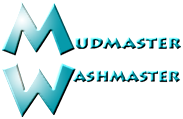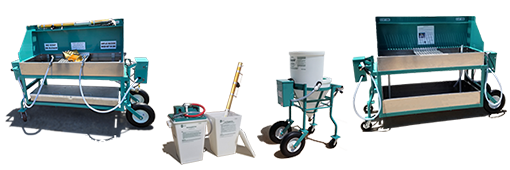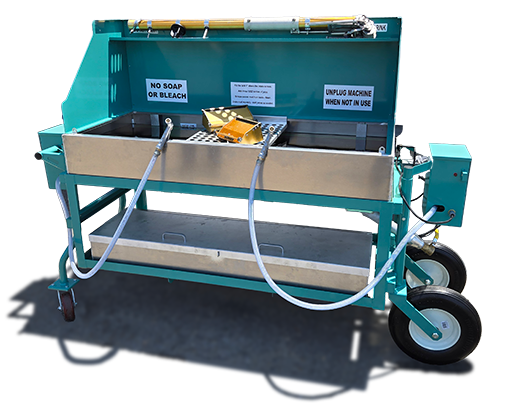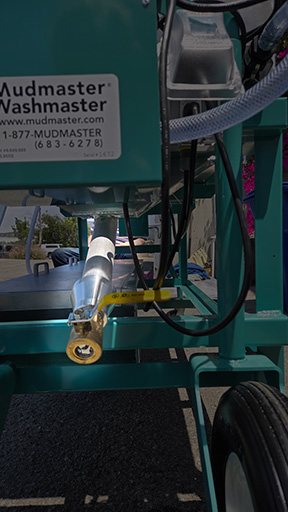

Don't Let Fast-Setting Mud Slow You Down – Clean Efficiently with Washmaster II

Properly cleaning your drywall tools is essential for maintaining their performance. Whether you're a professional contractor or a DIY enthusiast searching for "how to clean drywall tools" or "best way to clean drywall mud off tools," this guide has you covered. Discover step-by-step methods, eco-friendly drywall tool cleaning options, and how Mudmaster's Washmaster products revolutionize the process with water savings and EPA compliance.

Drywall tools like knives, pans, flat boxes, and automatic tapers (or as Ames names them: bazookas™) are the backbone of any finishing job. Leftover joint compound—commonly known as drywall mud—can harden quickly, clog mechanisms, and contaminates future batches of mud. Skipping regular cleaning shortens tool life.
The Mudmaster Washmaster series: innovative stations that recycle water, settle mud for reclamation, and control odors—making drywall tool cleaning tips easier and greener. With features like rapid mud separation using Washmaster Juice, you'll save on disposal costs while staying compliant with EPA guidelines for drywall mud waste.
Watch for our Washmaster Gel™, coming soon.
Why did I build the Washmaster?
I was on a job site with two Ames reps. As we walked around, the smell of sour, rotten mud permeated each floor. When the tapers stopped for lunch, I observed them washing their tools and hands in 55-gallon barrels of stinking water—YUCK! I remarked to my friends how unsanitary it was. Later, during lunch at a restaurant, I brought up the stinking water and the tapers eating with bacteria on their hands. My friends agreed we needed an on-site drywall tool cleaning system. Emptying the barrels required an expensive sanitary pump truck that wasn’t always on schedule. One suggested a flatbed truck with three large tanks and RV drains: wash in the first tank, let it overflow to the second, then to the third; pump water back to the first for drywall tool cleaning. Drain all tanks weekly at an RV station.
As a taper myself, I knew drywall tools must be cleaned right where they’re used. With an automatic taper jammed on paper, your wipe-down crew stands idle while you clear it. Using a man lift to reach a distant washout wastes time—and where do you park the truck?
The answer is the Washmaster I: 45 PSI with 3.5 GPM flow. Enough power to blast tools clean under water without splashing everywhere. Totally mobile, dependable, and easy to maintain. Add Washmaster Juice to settle mud fast, drain solids, then reuse clear water for mixing—perfect drywall tool cleaning on every job.
This unified process works for all tools—drywall knives/blades, mud buckets/pans, scoops, and automatic tapers. It combines traditional techniques (scrape, soak, brush, dry) with Washmaster enhancements for efficiency. For hot mud, use Washmaster II and Washmaster Juice..
Immediately after use and prior to washing, use a putty knife to scrape large excess mud into a waste bucket.
Washmaster Tip: Wash tools in a Washmaster station to capture mud in the settling tank, reducing waste by up to 90% by allowing premixed mud to be reclaimed.
Fill the Washmaster tank with water and add Washmaster Juice. Whether premixed or hot mud, Washmaster Juice settles mud in minutes (see the real time video), allowing water reuse—saving hundreds of gallons per job.
For premixed mud in the Washmaster II Commercial, submerge tools for 5–10 minutes to soften residue—saving time on tough buildup. Use a soft nylon brush (avoid wire to prevent scratches) for scrubbing knives, blades, and crevices, ensuring eco-friendly drywall tool cleaning without damage.
Note: Washmaster Juice excels at mud separation but won't soften set hot mud via soaking. For hot-mud tools, clean promptly in the Washmaster II before the mud's working time expires to maintain peak performance and extend tool life.
In Washmaster I or II, cycle through the recycle-water-system — no fresh water needed after an initial fill. Add more Washmaster Juice when water-mud separation slows. This conserves water, allows reclaiming of premixed mud, saves time, saves effort, and cuts costs.
Repeat at least daily for best results. But wash tools as often as you like. What took 30 minutes now takes 10 with Washmaster, per user feedback on Drywall Talk.
Washmaster II and II Commercial have drying racks. Wash water with Washmaster Juice does not need to be rinsed off. Our Juice has no effect or buildup on tools.

While traditional bucket methods work, they waste water, quickly smell bad, and create messy disposal problems. Washmaster elevates "drywall tool cleaning " with these advantages:
Washmaster I Washmaster II Washmaster Commercial Washmaster Pro

Yes! With Washmaster Juice, settled premixed mud can be collected and reused — test for consistency first as relaimed mud is often gritty. There are no adverse effects on mud or paint adhesion from Washmaster Juice, per our MSDS.
The Washmaster I and II Commerical are designed for reclaiming premixed drywall mud. The Juice separates water and mud. Mud settles to the bottom and can be collected from the drain valve (shown). Collect in a bucket. Give some time for water to come to the top, then pour it off. The remaining mud can then be added back into your mix.
The Washmaster II is for hot mud. Washmaster Juice works well with hot mud. The tank is designed for easy removal of the settled mud. There is no point in reclaiming waste hot mud. The Washmaster II is targeting reuse of the water.
At least daily to prevent mud adhering to tools. Quick rinses during breaks keep them workable.
When using hot-mud, tools need to be cleaned before your mud use time is up.

Washmaster Juice: Biodegradable, settles mud quickly without harsh chemicals, and promotes water reuse. The odor control we added in 2025 extends the working life of wash water. Definitly check our video showing how quickly Washmaster Juice™ separates water and mud keeping wash water cleaner for faster and more efficient cleaning.
Washmaster Gel™: (Coming Soon) this powder gels your mud and waste water allowing it to be disposed of as solid trash. No clogged drains or contaminated job site ground or EPA problem.
Use Washmaster II for quick dissolution; avoid letting it set on your tools. Scrape immediately and wash with the Washmaster Juice™ and water formula.

Drywall mud is considered non-hazardous solid waste in most jurisdictions, but wastewater must not be poured down drains. Use the Washmaster’s built-in separation: Juice settles solids in minutes for easy bucket removal and landfill disposal (check local codes). Clear water can be reused or evaporated onsite.
Pro Tip: Reclaim 70-80% of mud volume – saves money, cuts disposal costs and keeps you green.
Pro Tip: Use Washmaster Gel™ (Coming soon) to turn water into a solid waste, which can be disposed of with other non-hazardous solid waste.
Absolutely—by separating solids, it prevents contaminated wastewater discharge. Washmaster Gel adds a new step for safe, compliant disposal.

Upgrade to Washmaster today for faster, greener drywall tool cleaning. Save time, water, and money—while keeping tools pristine.
Shop Washmaster Products Contact Us for Advice
As a tradesman, I don’t have time for machines breaking down. We build in quality! Flat-free tires, quality castors, steel frames, and control panels. Before powder coating, all surfaces are primed with the same primer used on parking meters in Pacific Coast cities! Even our switches are the best — sealed switches rated for 100,000 throws. The pumps are also the best we could find. The pumps deliver 45 psi at 3.5 gallons per minute. When operated according to instructions, they too are long-lasting.
Recently, I was called for a repair. The machine was Washmaster #1, built in 2010. After replacing the pump, I noticed the tank was built before we had mold-in instructions. We replaced the tank. The machine was now 14 years old and as serviceable as a new one.
Washmaster Juice functions as a pump-saver by reducing solids in the water, eliminating odor and foam. The savings in drywall tool cleaning is in not having to discard the water as often, plus washing with cleaner water, exceeds the cost of the Juice!